程序可以運行,但實現不了表達式求值的功能,問題出在哪裡?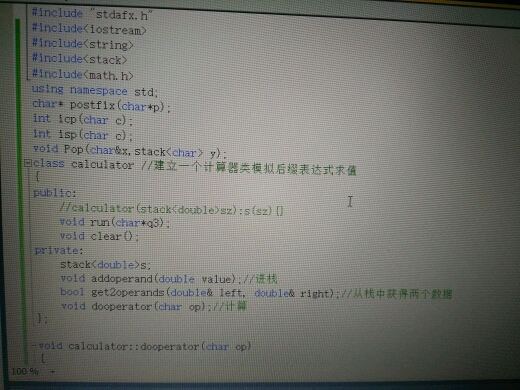
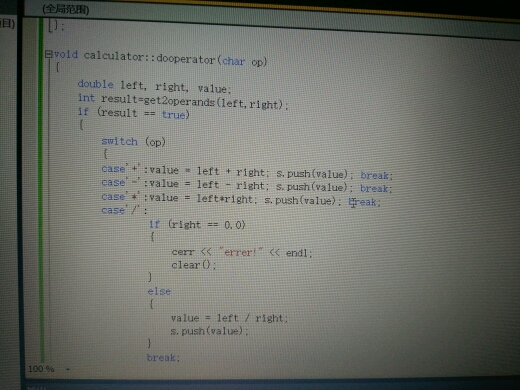
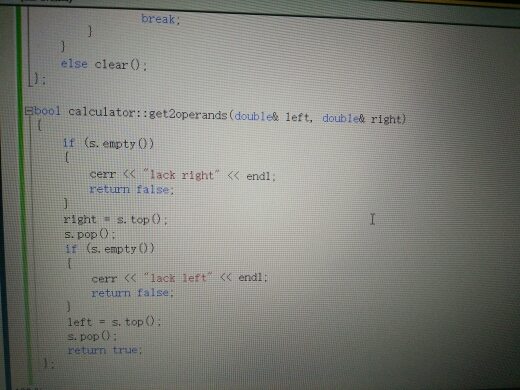
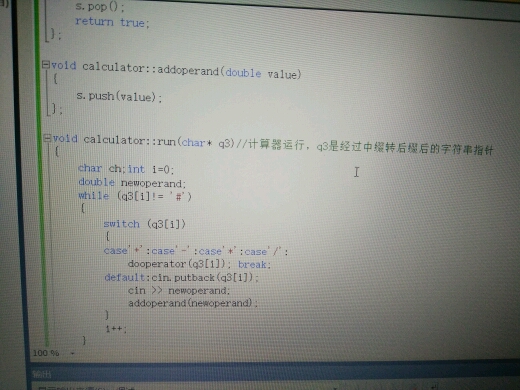
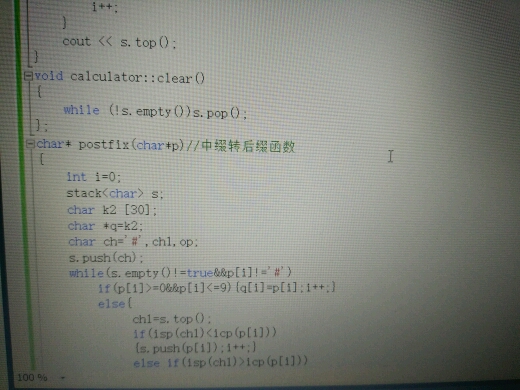
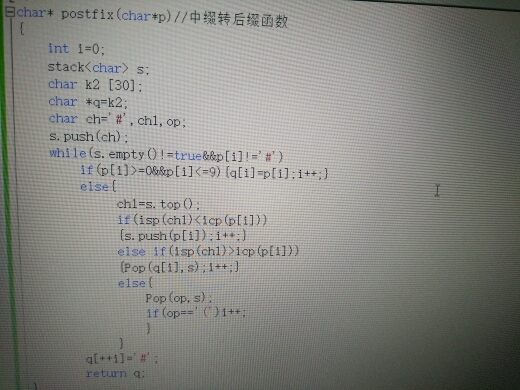
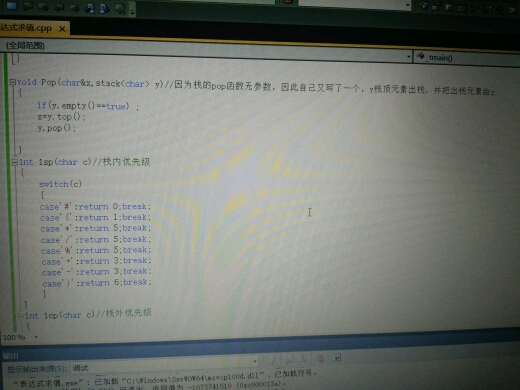

#include<stdio.h>
#include<string.h>
#include<stdlib.h>
#include<stack>
using namespace std;
#define N 1000
char infix[N]; //中綴表達式(未分離,都在一個字符串裡)
char expression[N][10]; //保存預處理過的表達式,也就是每個元素都分離過的表達式
char suffix[N][10]; //保存後綴表達式的操作數
int count;//表達式中元素的個數(一個完整到數字(可能不止一位數)或者符號)
int suffixLength;//後綴表達式的長度
int level(char a){
switch(a){
case '#':return 0;
case '+':
case '-':return 1;
case '*':
case '/':return 2;
case '^':return 3;
default:break;
}
return -1;
}
int isDigital(char x){
if( (x>='0'&&x<='9') || (x>='A'&&x<='Z') || (x>='a'&&x<='z') || (x=='.') )
return 1;
return 0;
}
int isNumber(char *str){
int i;
for(i=0;str[i];i++){
if(isDigital(str[i])==0)return 0;
}
return 1;
}
/*************************************
預處理中綴表達式,把連續的字符分離成不同的元素,用字符串數組(expression[][])
保存,方便後面的計算,因為這裡考慮了運算數可能不全是個位數
比如:(12+3)
在處理成後綴表達式時,是123+,容易產生歧義(1+23 ? 12+3)
*************************************/
void pretreatment(char *str){
int i,j,numberFlag;
char temp[3];
char number[10];
count=0;
numberFlag=0;
for(j=0,i=0;str[i];i++){
if(isDigital(str[i])==0){
if(numberFlag==1){
number[j]=0;
strcpy(expression[count++],number);
j=0;
numberFlag=0;
}
if(str[i]!=' '){
temp[0]=str[i];temp[1]=0;
strcpy(expression[count++],temp);
}
}
else {
numberFlag=1;
number[j++]=str[i];
}
}
puts("分離後的表達式為");
for(i=0;i<count;i++){
printf("%s ",expression[i]);
}puts("");
puts("");
}
/*****************************************
中綴表達式 轉 後綴表達式
遍歷字符串,對於str[i]
str[i]是運算數(或者是字母代替的運算變量)輸出;
str[i]是符號,有兩種情況
(1),是右括號,棧頂元素輸出,直到與str[i]匹配的左括號出棧(左括號不用輸出打印)
(2),是運算符,判斷str[i]與棧頂元素的優先級,str[i]優先級 不高於 棧頂符號,則棧
頂元素輸出,直到棧空 或者 棧頂符號優先級低於str[i]
*****************************************/
void infix_to_suffix(char str[N][10]){
memset(suffix,0,sizeof(suffix));
suffixLength=0;
stack <char*> st;
int i=0;
char Mark[2]="#";
st.push(Mark);
do{
if(isNumber(str[i])==1)//運算數直接保存到後綴表達式中
strcpy(suffix[suffixLength++],str[i]);
else if(str[i][0]=='(') //是 左括號,直接入棧
st.push(str[i]);
else if(str[i][0]==')'){ //是 右括號,棧頂出棧,直到與其匹配的左括號出棧
while( strcmp(st.top(),"(")!=0 ){
char temp[10];
strcpy(temp,st.top());
strcpy(suffix[suffixLength++],temp);
st.pop();
}
st.pop();
}
else if( strcmp(st.top(),"(")==0 )//是 運算符,且棧頂是左括號,則該運算符直接入棧
st.push(str[i]);
else { //是 運算符,且棧頂元素優先級不小於運算符,則棧頂元素一直
//出棧,直到 棧空 或者 遇到一個優先級低於該運算符的元素
while( !st.empty() ){
char temp[10];
strcpy(temp,st.top());
if( level(str[i][0]) > level(temp[0]) )
break;
strcpy(suffix[suffixLength++],temp);
st.pop();
}
st.push(str[i]);
}
i++;
}while(str[i][0]!=0);
while( strcmp(st.top(),"#")!=0 ){ //將棧取空結束
char temp[10];
strcpy(temp,st.top());
strcpy(suffix[suffixLength++],temp);
st.pop();
}
puts("後綴表達式為:");
for(i=0;i<suffixLength;i++){
printf("%s",suffix[i]);
}puts("");
puts("");
}
/**************************************
計算後綴表達式的值
**************************************/
char kt[N][10];
int stackTop;
void getResult(char str[N][10]){
stackTop=0;
/*這裡要注意,內存的分配方案導致 i 的位置就在temp[9]旁邊,然後strcpy()函數直接拷貝內存的話,在temp越界情況下會覆蓋 i 的值*/
int i;
char temp[10];
for(i=0;i<suffixLength;i++){
if(isNumber(str[i])==1){
strcpy(kt[stackTop++],str[i]);
}
else {
char a[10],b[10];
double na,nb,nc;
strcpy(a,kt[stackTop-1]);
na = atof(a);
stackTop--;
strcpy(b,kt[stackTop-1]);
nb = atof(b);
stackTop--;
if(str[i][0]=='+')nc=nb+na;
else if(str[i][0]=='-')nc=nb-na;
else if(str[i][0]=='*')nc=nb*na;
else if(str[i][0]=='/')nc=nb/na;
sprintf(temp,"%lf",nc);
strcpy(kt[stackTop++],temp);
}
}
puts("計算出後綴表達式的結果:");
printf("%s\n",kt[stackTop-1]);
}
int main(){
char temp[N];
while(gets(infix)){
strcpy(temp,infix);
pretreatment( strcat(temp," ") );
infix_to_suffix(expression);
getResult(suffix);
}
return 0;
}